|
Builder: Hendrickson Organ Co., Op. 26, 1974. Manuals: 2 Ranks: 25 Pipes: 1422 Stops: 32 Action: Electric key/stop Notes: Photos and information from Hendrickson shop. There are no pictures of the organ on Facebook. The third picture shows the balcony. The organ is behind the back wall. The room is in the shape of a cone, with the point at the altar. The organ speaks into the wrong end! The room is also fully carpeted. The 16' extension of the old Dulciana was new. The organist insisted on it. Organ Historical Society as of 2012. GREAT ORGAN 8 Principal 8 Rohrflöte 8 Dulciana 4 Octave 4 Flöte 2 Octave 1.1/3 Mixture IV Chimes Sw/Gt (8/4) SWELL ORGAN 8 Gedackt 8 Viola 8 Voix Celeste tc 4 Principal 4 Flute Harmonique 2.2/3 Nasard (FF) 2 Open Flute 1.1/3 Terz (TC) 1 Mixture III 16 Fagott 8 Trumpet 4 Clarion Tremolo Sw/Sw (16/4/Unison Off) PEDAL ORGAN 32 Resultant (derived) 16 Bourdon 32 16 Dulciana (Gt) 16 Gedackt (Sw) 8 Principal (Gt) 8 Bourdon 12 4 Octave (Gt) 4 Flute 12 2 Octave (Gt) 1 Octave (Gt) 16 Fagott (Sw) 8 Trumpet (Sw) 4 Clarion (Sw) Gt/Ped (8/4) Sw/Ped (8/4) |
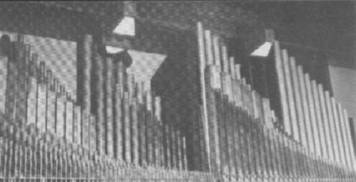 |
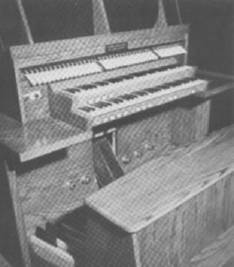 |
|
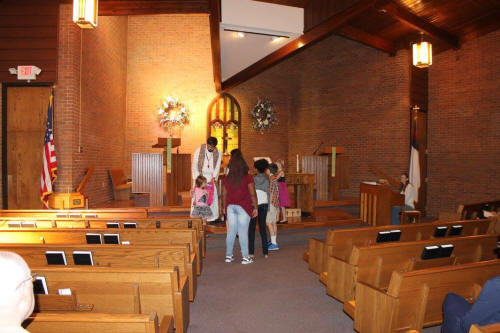 |
|
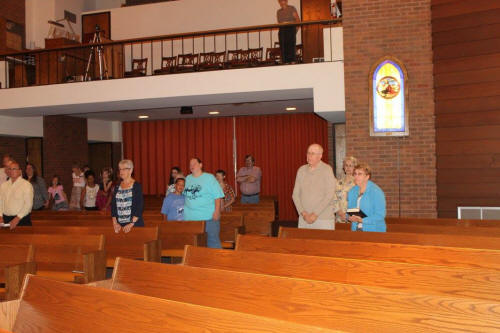 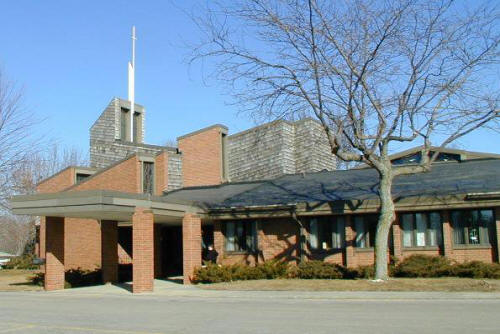 |
|
|
The pipe organ in the First Congregational Church of Fort Dodge,
Iowa has been built and installed by the Hendrickson Organ Company
of St. Peter, Minnesota. The instrument incorporates some of the old
ranks of pipes from the 1917 Hall pipe organ, which was installed in
the old church. However, the basic thrust of the instrument is a new
design utilizing all new mechanical and electrical systems to play
1422 pipes of the organ. The pipe organ is installed with the wind chests, blower, power supply, pipes and expressive swell box located in the organ area behind the choir in the balcony. A remote console containing the keyboards and controls is located in the choir and may be moved to any place in the balcony as it is connected to the main part of the organ by means of a flexible cable. The design of the organ is centered on the musical requirements of accompanying the congregation and the choir and for performing a variety of the important organ literature. The pipes of the organ are arranged in three sections according to the three keyboards of the instrument. There are 2 keyboards for the hands and one keyboard for the feet. Most of the visible pipes are played from the lower keyboard by the hands, the larger pipes at the rear of the organ area are played by the feet, and the upper keyboard for the hands plays the pipes which are enclosed in the wood box at the right side of the organ area. The front of this expressive box contains shutters which can be opened and closed by the organist to control the volume of sound. There are 25 ranks of pipes in the organ, of which 13 ranks are exposed and visible, and 12 ranks of which are enclosed in the swell box. Eleven old ranks of pipes have been used in the instrument and these were thoroughly reconditioned, cleaned and revoiced for the proper sound in the new organ. A small blower of 1/2 horsepower supplies the wind which makes the pipes speak and a system of wind reservoirs controls the wind for proper pressure to the wind chests which contain electric valves which turn the air on and off to each pipe. Each of the 1422 pipes has an electric valve to control the air, and a maze of wiring is necessary to connect all the valves to the electrical relays and switches of the instrument. |
|